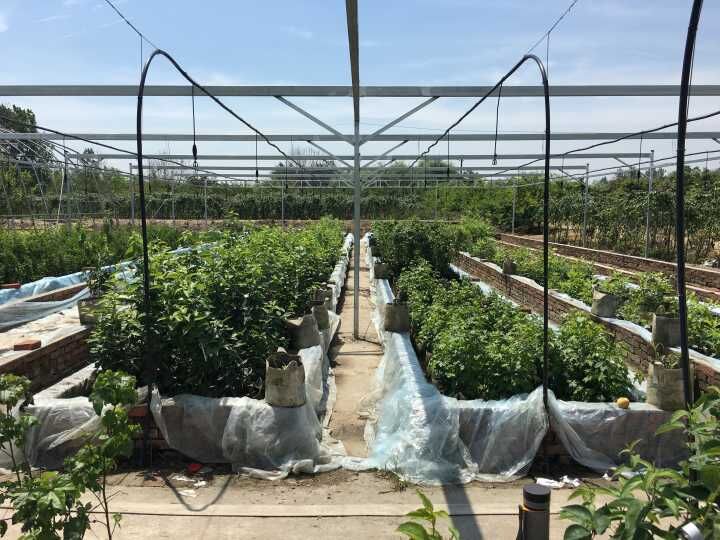 PDF(2652 KB)
PDF(2652 KB)


Effects of flooding stress on leaf color and photosynthetic fluorescence characteristics of Liquidambar styraciflua cutting seedlings in summer
ZHONG Lei, ZHANG Huanchao, FAN Junjun, ZHANG Dandan, JIANG Hao, ZHANG Wangxiang
Journal of Nanjing Forestry University (Natural Sciences Edition) ›› 2021, Vol. 45 ›› Issue (2) : 69-76.
 PDF(2652 KB)
PDF(2652 KB)
 PDF(2652 KB)
PDF(2652 KB)
Effects of flooding stress on leaf color and photosynthetic fluorescence characteristics of Liquidambar styraciflua cutting seedlings in summer
 ,
,
【Objective】The purpose of this experiment is to estimate the flooding resistance of Liquidambar styraciflua and to analyze the flooding resistance mechanism, combined with the synergy of leaf color, leaf pigments and photosynthetic fluorescence characteristics.【Method】The dynamic trends of growth, leaf color (color parameters and pigment ratio), photosynthetic characteristics [net photosynthetic rate (Pn), transpiration rate (Tr), stomatal conductance (Gs), intercellular CO2 concentration (Ci)]; and chlorophyll dynamic fluorescence characteristics [leaf reaction center number (NRC/CSm), efficiency by trapped exciton (Ψo), quantum ratio for electron transfer (φRo), quantum yield of electron acceptor at the end of acceptor side (φEo), dissipation (EDIo/CSm), and performance index (Itotal)] of one-year-old cuttings of L. styraciflua were analyzed under 60 days of flooding treatment outdoors in summer at high temperatures. 【Result】①The growth of L. styraciflua was not inhibited by flooding treatment after 60 days, and the survival rate of cuttings was still up to 90%. ② The leaf color parameter (h) decreased significantly with prolongation of flooding. After 40 days, the color of the leaves changed from green to red (h< 90°). ③ The relative content ratio of chlorophyll to anthocyanin and carotenoid [Chl/(Anth+Car)] showed a significant decreasing trend after 20 days. After 40 days, the ratio of pigments was less than 1. The change in pigments was synchronized with that of the leaf color parameters. ④ The trend of photosynthetic gas exchange parameters of treated cuttings was similar to that of the control. Both Pn and Ci showed downward-upward-downward trend, while Tr and Gs showed downward trend. In the early stage of flooding (0-20 days), there was no significant difference between the treatment and control groups, but in the late stage of flooding (20 days later), the values of each parameter were significantly lower than that of the control, and the difference between them increased. ⑤ The characteristics of the light response curve showed that the Pn of the treatment was significantly lower than that of the control, and with flooding prolongation, the difference in Pn between the treatment and control was larger than that of the control, which indicated that the light utilization rate of the treatment was lower. ⑥ With prolonged flooding (after 30 days of flooding), the number of leaf reaction centers (NRC/CSm) and the energy of electronic transmission from PSII to PSI (Ψo, φRo and φEo) were significantly decreased, and the EDIo/CSm was significantly increased, which resulted in a decrease in the performance index (Itotal). 【Conclusion】The L. styraciflua has strong short-term flooding tolerance. All indexes of treatments were better than those of the control in the first 20 days. This was because of the reduction in excitation energy generation and excess excitation energy damage by increasing the heat dissipation of leaves, thereby adjusting the weight of the photosynthetic pigment content. There was synergism among net photosynthetic rate, leaf pigment ratio and fluorescence parameters, and the time of inflection of each parameter changed rhythmically, that is, 20, 30 and 40 days, respectively. The photosynthetic parameter response was the most sensitive.

flooding stress / Liquidambar styraciflua / color space / characterization of photosynthesis / chlorophyll fluorescence / synergy / summer
| [1] |
顾佳清, 张智奇, 周音, 等. 树种耐水湿筛选研究综述[J]. 上海农业学报, 2004,20(4):66-69.
|
| [2] |
|
| [3] |
张往祥, 张晓燕, 曹福亮, 等. 涝渍胁迫下3个树种幼苗生理特性的响应[J]. 南京林业大学学报(自然科学版), 2011,35(5):11-15.
|
| [4] |
|
| [5] |
|
| [6] |
丁红, 张智猛, 戴良香, 等. 水分胁迫和氮肥对花生根系形态发育及叶片生理活性的影响[J]. 应用生态学报, 2015,26(2):450-456.
|
| [7] |
俞继红. 3种彩叶植物的光合特性比较[J]. 西北林学院学报, 2014,29(4):21-25.
|
| [8] |
郭彩霞, 陈法志, 童俊, 等. 几种彩叶植物的耐热抗寒性研究[J]. 黑龙江农业科学, 2010(10):77-79.
|
| [9] |
于永根, 蔡开锋, 薛文虎, 等. 北美枫香引种栽培试验研究[J]. 河南林业科技, 2012,32(2):8-10.
|
| [10] |
苏梦云. 美国枫香茎段组织培养与植株再生[J]. 林业科学研究, 2005,18(1):98-101.
|
| [11] |
|
| [12] |
|
| [13] |
|
| [14] |
|
| [15] |
|
| [16] |
|
| [17] |
|
| [18] |
聂庆娟, 史宝胜, 孟朝, 等. 不同叶色红栌叶片中色素含量、酶活性及内含物差异的研究[J]. 植物研究, 2008,28(5):599-602.
|
| [19] |
张敏, 黄利斌, 周鹏, 等. 榉树秋季转色期叶色变化的生理生化[J]. 林业科学, 2015,51(8):44-51.
|
| [20] |
苏金, 黄婧, 周鹏, 等. 黄金枸骨变色期的叶色与叶片光合色素含量关系研究[J]. 江苏林业科技, 2019,46(4):33-36.
|
| [21] |
|
| [22] |
|
| [23] |
|
| [24] |
衣宁, 赵文倩, 刘倩, 等. 油松新生叶与老叶光合功能的比较[J]. 林业科技, 2014,39(6):10-14.
|
| [25] |
杨小鑫, 吕运舟, 董筱昀, 等. ‘金焰彩栾’与黄山栾树光合特性比较[J]. 南京林业大学学报(自然科学版), 2016,40(4):74-80.
|
| [26] |
董贞芬, 门宇恒, 邹秋滢, 等. 叶绿素荧光成像在植物生长环境胁迫中的应用[J]. 沈阳农业大学学报, 2019,50(2):250-256.
|
| [27] |
|
| [28] |
刘晓军, 唐晓波, 李春华. 不同绿茶品种秋季叶绿素与光合效率比较及相关性研究[J]. 西南农业学报, 2008,21(4):975-978.
|
| [29] |
|
| [30] |
朱向涛, 金松恒, 哀建国, 等. 淹水胁迫下江南牡丹生长及光合特性研究[J]. 广西植物, 2016,36(8):956-962.
|
| [31] |
杨小苗, 吴新亮, 刘玉凤, 等. 一个番茄EMS叶色黄化突变体的叶绿素含量及光合作用[J]. 应用生态学报, 2018,29(6):1983-1989.
|
/
| 〈 |
|
〉 |